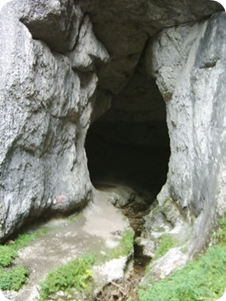The Western Carpathians
The Western Carpathians are the lowest of the three ranges and are fragmented by many deep structural depressions. They have historically functioned as "gates," which allow easy passage but can be readily defended. The most famous of these is the Iron Gate on the Danube. The Western Carpathians are the most densely settled, and it is in the northernmost area of this range, the Apuseni Mountains, that permanent settlements can be found at the highest altitudes.
Apuseni Mountains
By far the most outstanding of the Western Mountains are the Apuseni. Their name translates from Romanian as Mountains  "of the sunset" i.e. "western". Though their peaks are not higher than 1850 m (maximum elevation 1,849 m, the Curcubata Mare Peak in the Bihor Mountains), they dominate the low surrounding area as a uniform, imposing group. They are unique mountains within the Carpathians, a combination of wilderness and the most traditional rural civilization as human settlement extends to the highest altitudes. The place of bare rock and abrupt walls so specific to the other Romanian mountains, is taken by rounded hills covered in luscious forests and pastures for wild horses. The mountains display picturesque landscape with houses and hay piles scattered on the most often karstic plateaus, many of them split by wild gorges. The Motii (inhabitants of Western Carpathians) are very good storytellers. They kept the old traditions and they have a wonderful folklore.
"of the sunset" i.e. "western". Though their peaks are not higher than 1850 m (maximum elevation 1,849 m, the Curcubata Mare Peak in the Bihor Mountains), they dominate the low surrounding area as a uniform, imposing group. They are unique mountains within the Carpathians, a combination of wilderness and the most traditional rural civilization as human settlement extends to the highest altitudes. The place of bare rock and abrupt walls so specific to the other Romanian mountains, is taken by rounded hills covered in luscious forests and pastures for wild horses. The mountains display picturesque landscape with houses and hay piles scattered on the most often karstic plateaus, many of them split by wild gorges. The Motii (inhabitants of Western Carpathians) are very good storytellers. They kept the old traditions and they have a wonderful folklore.
But the wonders of the Apuseni are not above, but underground: it's caves. There are about 400 of them here. Hidden in deep valleys are extensive limestone formations that give rise to some spectacularly eroded scenery. The whole region is like a big, white chunk of swiss cheese, thoroughly carved by underground rivers for millions of years. The forests hide sinkholes, which are like magical gates to the kingdom below. The most impressive is called Cetatile Ponorului, where the powerful river managed to pierce a passage through a whole mountain, giving birth to an immense natural bridge. Another unique place is a cave called Focul Viu (the Live Fire), which owes its name to a curious lighting effect.  The summer sun shines through a tiny opening at a precise time of the day, and bounces off the glacier inside the cavern, illuminating the walls with a strange glow. Yet another favorite spot is Scarisoara cave, site of a large underground glacier. Farther away in the northern range of the Apuseni, lies the most beautiful of all Romanian caves. It is called Pestera Ursilor (The Bears' Cave), and was discovered less than 20 years ago. It owes its name to the remains of an ancient species of bear that were discovered here.
The summer sun shines through a tiny opening at a precise time of the day, and bounces off the glacier inside the cavern, illuminating the walls with a strange glow. Yet another favorite spot is Scarisoara cave, site of a large underground glacier. Farther away in the northern range of the Apuseni, lies the most beautiful of all Romanian caves. It is called Pestera Ursilor (The Bears' Cave), and was discovered less than 20 years ago. It owes its name to the remains of an ancient species of bear that were discovered here.
The Apuseni Mountains are fast becoming an agrotourism and ecotourism hotspot, as they offer wonderful scenery, secluded areas, great Romanian social and rural experiences, as well as a spirit and mood that is unbeatable. Despite still being fairly hard to access, especially by public transport, the Apuseni Mountains make for a great off-the-beaten track destination. Their gateway town, Huedin, is very easy accessible by train.
............................................................................................................................................
